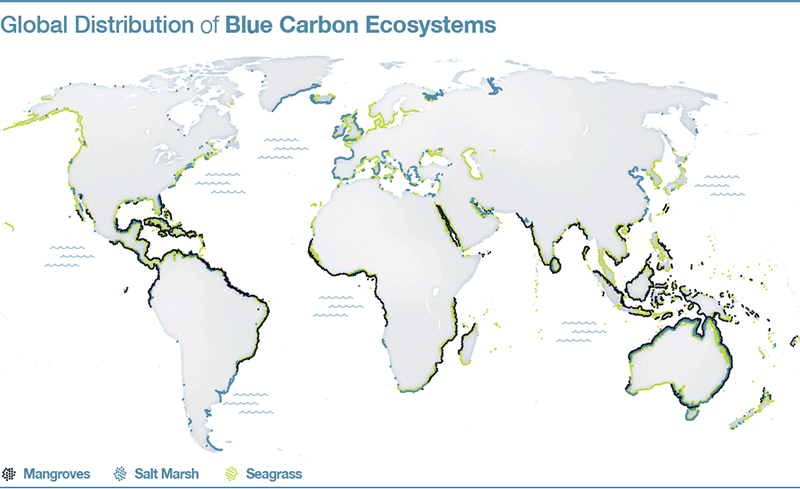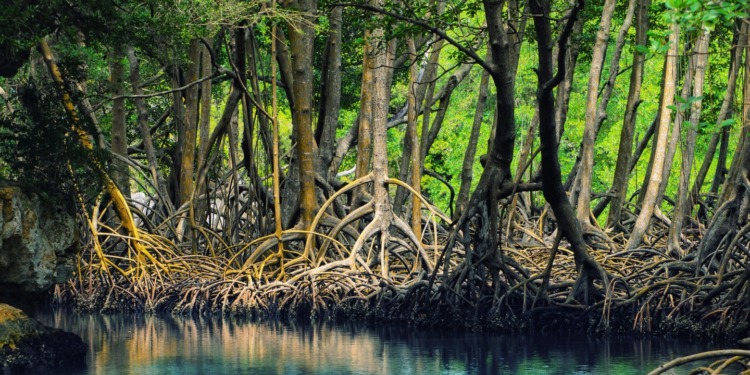Blue carbon is the carbon stored in coastal and marine ecosystems. In addition to provoding essential ecosystem services, coastal ecosystems, such as mangroves, tidal marshes and seagrasses, sequester and store large quantities of blue carbon in both the plants and the sediment below.
The latest McKinsey & Company report, “Blue Carbon: The potential of coastal and economic climate action,” accentuates the importance of blue carbon. It highlights how nature-based climate solutions in the world’s oceans can play an important role in conservation and carbon reduction efforts worldwide.
McKinsey’s findings show that if fully implemented, blue carbon solutions would cut total current annual emissions by 1-3%, or by 0.4-1.2 metric gigatons (Gt) of CO2. That potential jumps to approximately 3 GtCO2 of annual decrease, which is about 7% of the total current annual emissions. Annual human emissions are currently around 40 GtCO2.

In addition, the report shows that there are potentially significant ecosystem benefits when implementing blue carbon solutions. For example, as mangroves recover, fish and marine-fauna populations will expand, supporting both fisheries and nature-based tourism, as well as maintaining coastal protection.
As McKinsey writes in the report, the oceans and coasts are the Earth’s climate regulators.
“Covering 72% of the planet’s surface, they have absorbed around 40% of carbon emitted by human activities since 1850. Coastal ecosystems such as mangroves, tidal marshes, and seagrass meadows act as deep carbon reservoirs, while marine ecosystems and fauna absorb and sequester greenhouse gases (GHG) through the carbon cycle,” the report explains.
Both oceans and coasts, however, are now under great pressure due to atmospheric and marine warming, habitat destruction, pollution, and the impacts of overfishing and industrial activity. “These destructive factors undermine the significant role of oceanic systems in slowing climate change,” McKinsey concludes.
Blue carbon credits
Efforts can be made in order to avert damage to or restore the oceans. One of the key tools to tackle climate change is the carbon market, which allows organisations to trade emissions allowances to achieve reduction targets.
“Carbon offsetting”, which means receiving credit for reducing, avoiding, or sequestering carbon, has become part of the solutions to mitigate carbon emissions, and thus climate change. Global demand for carbon credits is soaring as companies aim to meet the United Nations Sustainable Development Goals (SDGs) and offset their emissions. By 2050, carbon offsets are expected to be a $245-$546 billion market, according to BloombergNEF, Bloomberg’s clean energy research group.
Projects are being developed globally to protect and restore coastal ecosystems for their “blue” carbon value.
“The market is small but growing exponentially,” said marine ecologist Oscar Serrano at Edith Cowan University in Perth, who has helped to catalog the capacity for Australia’s blue carbon reserves in mitigating climate change. As Amy Schmid, ecologist and manager of natural climate solutions development for Verra, a nonprofit corporation that develops and manages standards to help achieve climate action goals, confirms, “there’s a lot of demand for blue carbon credits. Companies in shipping and tourism are keen to put money back into conserving the landscapes they have an impact on, while offsetting their own emissions.”
Last month, Bahamian Prime Minister Philip Davis announced that his country expects to sell blue carbon credits from the island’s seagrasses and mangroves on the international market by year’s end. Officials have identified at least $300 million worth of assets that might be offered on the voluntary carbon market. If the Bahamas starts selling ocean-based credits, it would be among the world’s first countries to do so.
Officials will be holding a regional meeting in the coming period in hopes of bringing other Caribbean nations into the initiative. “I want to see a Caribbean that is not dumped on any further,” Prime Minister Davis said. “We are a major carbon sink for the world, and we need to benefit from cleaning the Earth’s atmosphere.”
Importance of preserving coastal and marine ecosystems
When protected or restored, blue carbon ecosystems sequester and store carbon. However, when degraded or destroyed, these ecosystems emit the carbon they have stored for centuries into the atmosphere and oceans, becoming sources of greenhouse gases themselves. Experts estimate that as much as 1.02 billion tons of carbon dioxide are being released annually from degraded coastal ecosystems.
Mangroves, tidal marshes and seagrasses are critical for supporting coastal water quality, healthy fisheries, and coastal protection against floods and storms. The ocean’s capacity for keeping global warming in check — while also providing food, boosting biodiversity, and protecting local coasts from storms and tides — is huge.
“The ocean has long been seen as a victim of climate change, but it’s also a big part of the solution,” says National Geographic explorer-in-residence Enric Sala, who studies blue carbon.
Overall, blue carbon credits could channel much-needed funds into projects across the world that seek to restore coastal ecosystems and prevent the release of carbon dioxide into the atmosphere. The blue carbon market may be crucial in order to protect the world’s oceans, and simultaneously combat climate change.
Editor’s Note: The opinions expressed here by Impakter.com columnists are their own, not those of Impakter.com — In the Featured Photo: Mangrove forest. Featured Photo Credit: The Australian Rivers Institute (ARI), via Wiki Commons.










